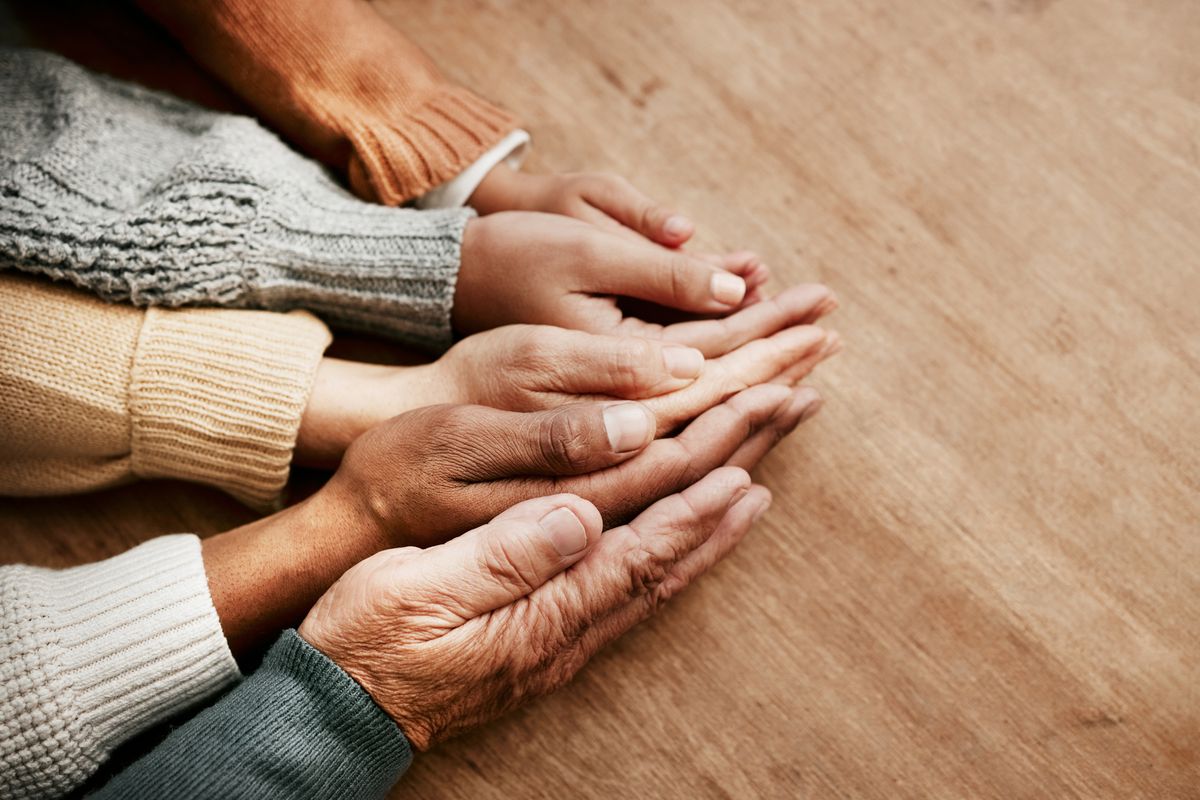👋 Taking care of your family is a delicate balance that many of us navigate each day: Who will stay home with the sick child? Who can get off work to pick up a toddler from daycare? Who’s keeping track of vaccinations and well-child visits?
It’s stressful in the best of times.
And then your parents face health issues.
That delicate balance is thrown off as your responsibilities expand: Different doctors and different types of care. Frequent trips to the hospital. Long-distance care management. Conversations about independent living.
Families sandwiched between caring for children and parents, while maintaining a job and their own well-being, face skyrocketing stress levels — and financial costs. For families already struggling to make ends meet, the challenges are even greater. Paid family leave and Medicaid can help, but there’s no set of policies specifically to help family caregivers.
This issue of Starting Early looks at ways to support the sandwich generation, so their kids can thrive and their parents get the care they need.
Atiya Weiss
Executive Director, the Burke Foundation
1 big thing: Better care for parents, children, and self

Defined as people from about 35 to 59 who care for their children while also helping to support their aging parents, the “sandwich generation” has a stressfully full plate when it comes to caregiving. The burden falls disproportionately on women, most of whom have full-time jobs and are in their peak earning years.
The number of families in this position is rising, as more women are in the workforce, couples wait longer to have children, and their parents’ life spans increase.
By the numbers: Those caring for both children and parents or other older adults make up a significant portion of the adult population, and it strains many families’ finances.
- About 50% of U.S. adults in their 40s have a parent over 65 and a child younger than 18 or provide financial support to an adult child.
- Almost half of sandwich generation adults say their household couldn’t meet essential expenses in the past year due to caregiving costs.
- 7% of caregivers of any age report getting insufficient sleep, which contributes to health problems including high blood pressure and depression.
2. One solution: Paid family leave

The U.S. is the only industrialized nation without a national family paid leave policy.
New Jersey is one of just 13 states (and the District of Columbia) where employers are required to provide paid family leave. Most of these states fund the program through payroll taxes on the employee or employer. New York requires employers to purchase insurance through a private provider.
- The Bipartisan Policy Center offers an excellent overview of different states’ policies.
More than maternity leave: Many don’t realize that these programs are often available for a wide variety of family needs, well beyond maternity/paternity leave or caring for a sick child. For urgent situations, where a parent needs immediate and ongoing care, New Jersey’s employee-funded Paid Family Leave provides compensation for up to 12 weeks per year. New Jersey Paid Family leave can assist those caring for parents, grandparents, parents-in-law, spouses, and more.
It’s important to note that New Jersey’s paid leave benefit doesn’t cover an applicant’s full salary.
Too many are left out across the nation: According to the federal Bureau of Labor Statistics, nearly 73% of private sector employees nationwide don’t have access to paid family leave. And only 5% of the lowest-paid workers have any type of paid leave.
- Federal employees, while able to receive up to 12 weeks paid leave for birth or adoption, aren’t eligible for paid benefits to care for other family members.
- With no federal policy covering paid leave for workers, state legislatures offer the most hope. In the past year, 34 states introduced statewide paid family leave legislation, and Maine and Minnesota enacted 12-week paid family leave programs.
💡A bright spot: combined care💡
One approach gaining traction is to make both child care and adult care available at the same site. The theory is that both children and elders benefit from intergenerational interaction – and there are many programs that match older adults as mentors or tutors with children. But in some facilities, full-time care is offered for both generations. Typically, care is provided in separate sections of a site, with some intergenerational areas like craft rooms, gyms, and cafeterias where young and elderly people can spend time together.
One example is the Champion Intergenerational Enrichment and Education Center in Columbus, Ohio. Champion provides preschool and early childhood education, adult day services, support for caregivers and parents, and basic medical assistance. Activities are designed to build relationships, improve health and wellness, develop educational skills in children, and create a sense of purpose in the elderly. 🧓💕👶
3. Tools you can use

These tools are available to help caregivers in a variety of ways, including:
✅ Learning the ins and outs of providing care for a family member
- The Family Caregiver Alliance suggests forming an agreement among siblings to help protect family members who may provide full-time care by setting clear expectations and compensation.
- This brief guide from gov explains options that include being paid for caring for a family member.
- Caregiver Action Network offers education and resources for family caregivers, including a helpline, support groups, and an online community. You can contact CAN on its website or by calling 1-855-227-3640.
✅ Finding care, housing, and other services for elderly family members
- Eldercare Locator, a service of the S. Administration on Aging, can help connect you to local resources and support services for caregivers. You can contact them at 1-800-677-1116 or visit their website.
- DOROT offers community and connections for aging adults, including online programs for people outside their service area.
- Elderwerks provides information, referrals, and guidance for those seeking help to care for an aging loved one.
✅ Mental health supports for caregivers
- A major source of stress for the sandwich generation is the financial burden of caregiving. The Currencyprovides advice on lessening the financial pressure.
- Mental Health Americashares resources for caregivers, including what to do in a crisis.
- The American Psychological Associationoffers tips for managing stress, including healthy behaviors that reduce stress, taking care of your body, and seeking professional help.
- Sometimes it helps just knowing you’re not alone. Family Caregiver Alliance shares stories from people in similar situations.
3. One smile to go: Inspiration from abroad

Despite the challenges of multi-generation care, great joy and support can be found in a multi-generational community. Joe Waters, co-founder and CEO of Capita, a global think tank focused on children and families, recently shared his experience in a community that truly put families first. During 3 weeks in the Umbria region of Italy with his wife, toddler, and weeks-old newborn, Joe discovered a family-centered community that went out of its way to support them.
In a newsletter reflection, Joe eloquently observed: “We are all connected, a baby is a baby, a seed of hope for each and all, no matter who the parents are.”
Here are a few of his insights:
- A child-friendly tone for a place is set at the airport. If you arrive with a baby, a toddler, strollers, car seats, and so many pieces of luggage I lost count, you are helped by airport staff and shown the way to a fast passport lane.
- People love to see newborns in their cities and neighborhoods. Italians, especially those of a certain age, take pleasure in stroking our baby’s hair or gently touching her feet. They don’t ask permission, which, while a little unnerving at first, is a good reminder that “our” baby isn’t ours but a gift to all, as every baby is.
- A child-friendly city has more to do with the absence of cars than the presence and prevalence of child-centric play spaces. We watched our son step out to play with the local kids—in the street. This is a mostly pedestrian zone, but the kids know how to react when a car or bike comes by. Yet cars rarely appeared, and when they did, they were of modest size and moving at a genuinely safe pace. The streets are for people, not cars, so they’re for child’s play too.
- No matter how young your child is or in what language we speak, when other parents see a newborn, they want to tell you about their kids—how old they are, where they live now, what they remember from the newborn months, and what their grandkids are up to. As President John F. Kennedy said, “Our most basic common link is that we all inhabit this small planet. We all breathe the same air. We all cherish our children’s future. And we are all mortal.”
Thanks, Joe. Your stories inspire us! 🌟🌈🥰
The roundup
- Investing in women: Philanthropist Melinda French Gates has committed to donating $1 billion over the next 2 years to organizations working on behalf of women and families.
- Learning from global experience: The Robert Wood Johnson Foundation hosts a June 7 webinar on how to build a Culture of Health in the U.S., based on lessons learned from health workers around the world.
- Working for better futures: Prenatal-to-3 Policy Impact Center is hiring for positions in research, data analysis, and event coordination.
- Focusing on child care: Presented by Ascend at the Aspen Institute and produced by Three Frame Media, Raising Up is a short film series elevating the narratives of student parents and innovative leaders creating generational impact.
